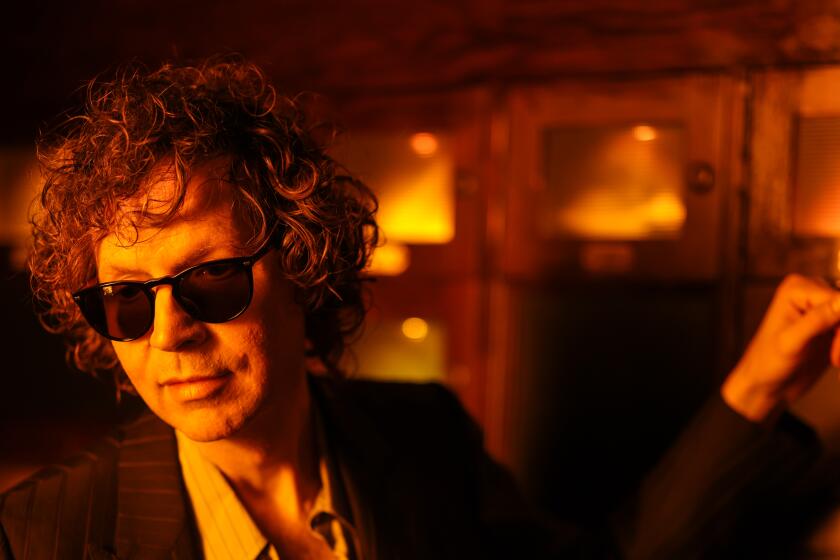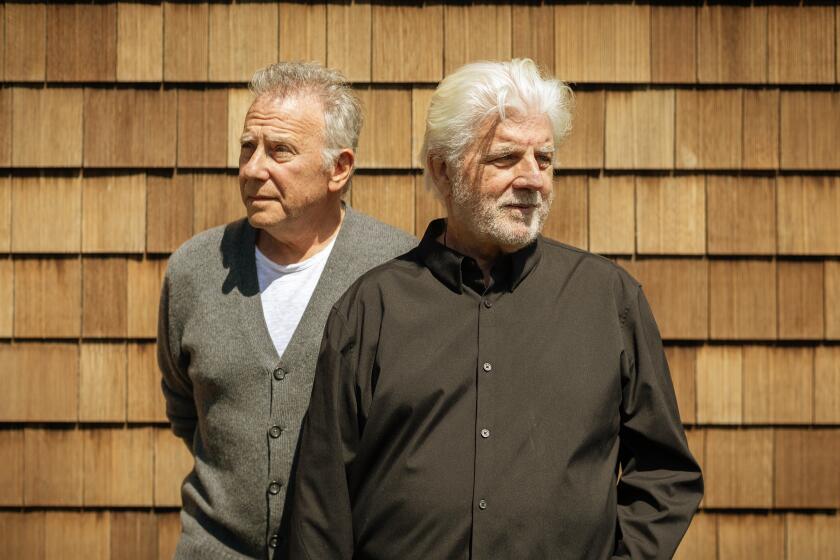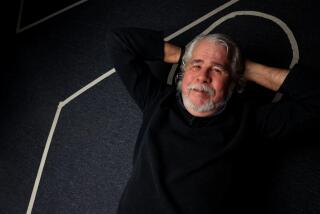How Dead & Company found new life at the Las Vegas Sphere
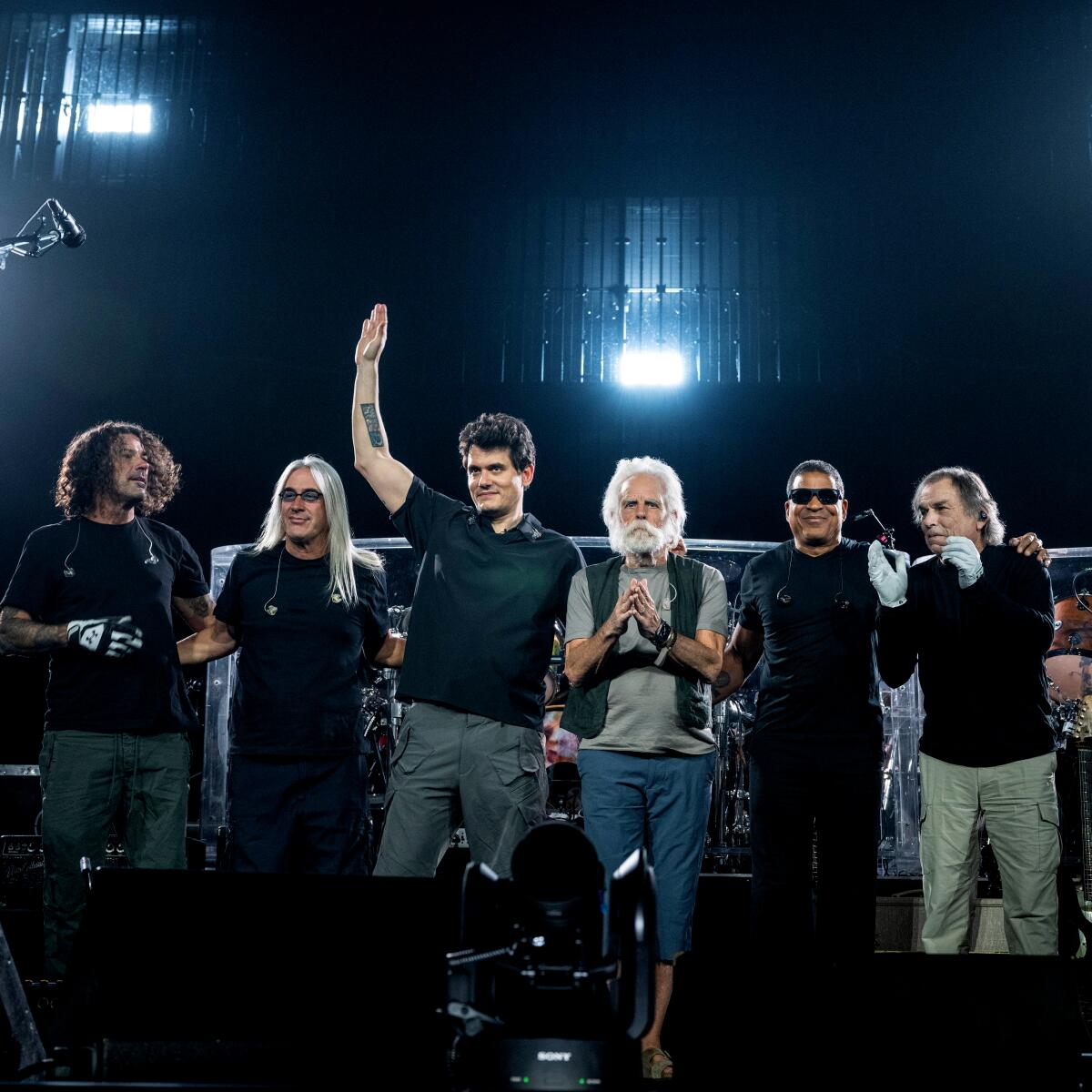
- Share via
LAS VEGAS — Four hours or so before they’re due beneath the massive wraparound video screen at Sphere, Bob Weir, Mickey Hart and John Mayer amble into a backstage production office like three guys showing up — again — for the work of blowing 17,000 minds.
“Nice to meet you,” Mayer says, grinning as he extends a hand. “John Mayer, Mayer Industries.”
As original members of the Grateful Dead, guitarist Weir, 76, and percussionist Hart, 80, are jam-band royalty; Mayer, 46, is the singer and guitarist known for pop hits like “Gravity” and “Your Body Is a Wonderland.” Together they represent the nucleus of Dead & Company, which on this recent afternoon has just passed the halfway mark of a 30-date summer residency at Sphere, the state-of-the-art dome-shaped venue behind the Venetian resort on the Las Vegas Strip.
Not that they’re counting.
“Halfway? If you say so,” Weir says as he lowers himself into the lotus position on a sofa next to his bandmates. Adds Hart, his hands encased in his trademark white golf gloves: “This is just a habit for us. We keep coming back here three days a week and playing our stuff.”
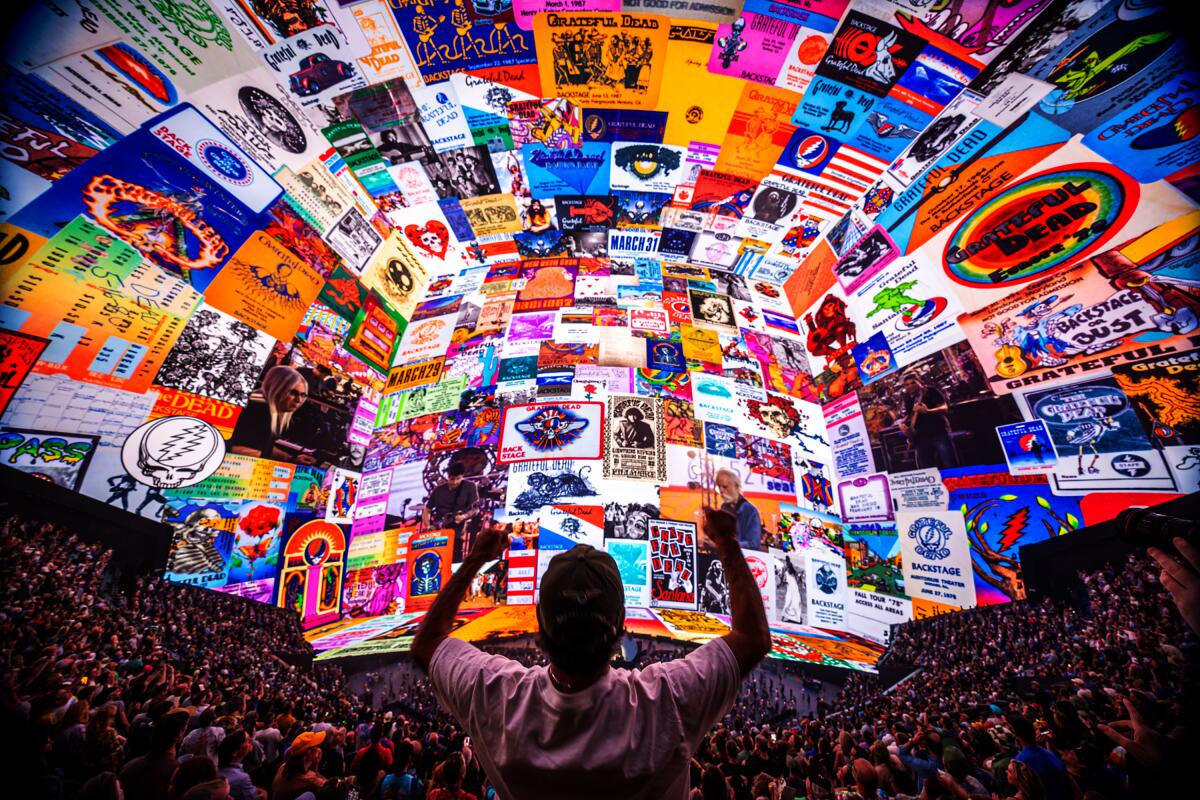
A year ago, they seemed poised to shake that habit: Having logged more than 200 gigs since 2015 — when the band came together in the wake of a public farewell by the Grateful Dead — Dead & Company wrapped up what was billed as its own final tour that July with three concerts at Oracle Park in San Francisco, where the Grateful Dead formed in the mid-1960s and quickly became an avatar of the city’s Haight-Ashbury counterculture. (The other members of Dead & Company are bassist Oteil Burbridge, keyboardist Jeff Chimenti and drummer Jay Lane, the last of whom replaced Bill Kreutzmann, another Grateful Dead founder, after Kreutzmann left in 2023.)
Yet the prospect of Sphere’s visual splendor lured the group back onstage.
With a 160,000-square-foot screen said to be the highest-resolution in the world, the $2-billion venue opened to much fanfare last fall with an eye-popping show by U2 that put the veteran Irish band amid photo-realistic images of the Vegas desert in the pre-neon age; Phish followed U2 into Sphere in April, turning the building’s curved surface into an underwater lair and the soapy interior of a car wash.
Ahead of a show with the L.A. Phil at the Hollywood Bowl, Beck takes a look back at his decades-long career.
Mayer reckons that the venue has “established overnight a new big league” of acts eager — and able — to take advantage of Sphere’s technical potential.
“I think what we all love is that there’s finally once again a live-music space race,” he says, dressed in tan cargo pants and a clingy black T-shirt. “There’s the social-media space race, the podcast space race, the AI [artificial intelligence] space race. But live music pretty much stayed the same for such a long time.”
Mayer insists it’s not ego that’s driving musicians to play Sphere — “Well, it’s a little ego,” he clarifies — but rather the drive “to delight and surprise people more than they expected to be with this big, empty canvas and this really big palette.”
Amid the other offers Dead & Company fielded for engagements that didn’t require extensive travel, Hart says, “This was a very juicy option.”
Dead & Company’s residency, which is called Dead Forever and runs through Aug. 10, has been a clear box-office success, with an average nightly gross of approximately $4 million, according to the band; what’s more, the group says that nearly a third of concertgoers have bought tickets for more than one date — repeat business likely to correspond with a hefty spend at Dead & Company’s pop-up merch store at the Venetian, where fans can buy T-shirts, hoodies, even a pair of handmade Belgian loafers emblazoned with the band’s cheerful dancing bear logo. (The shoes will run you $395.)
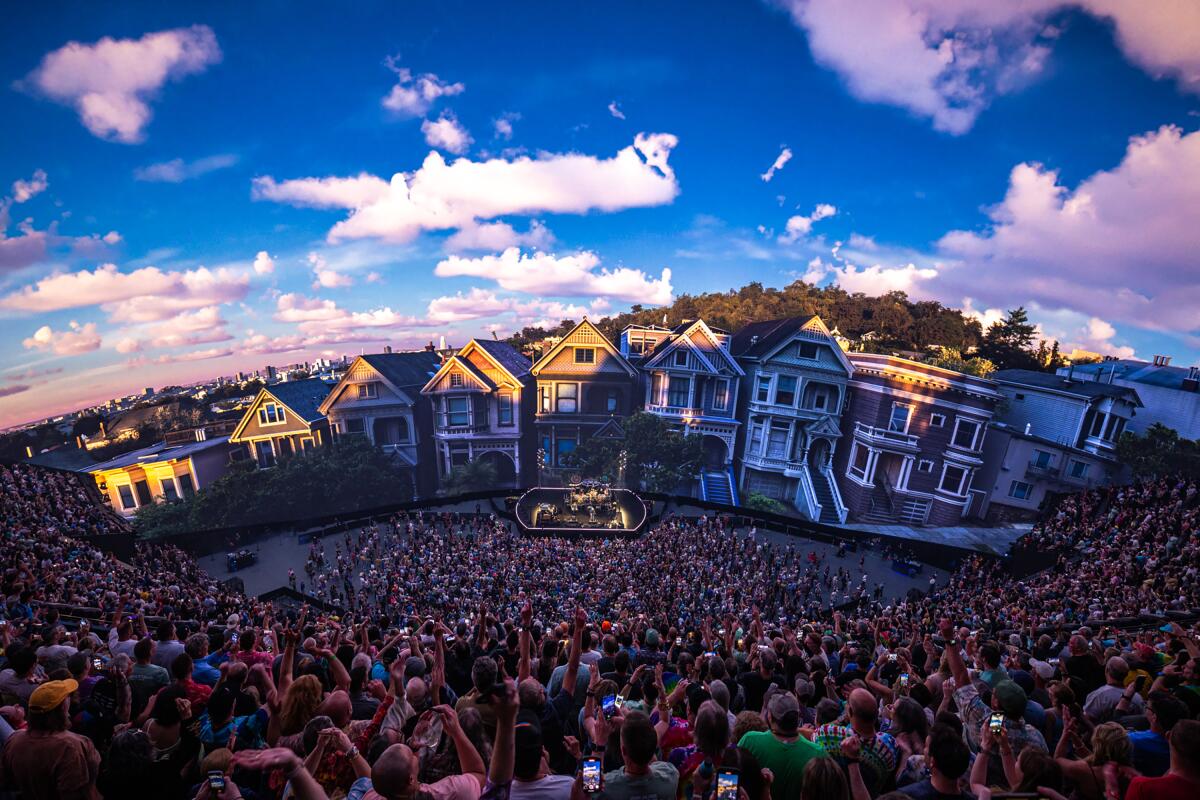
More important, Dead Forever is an artistic triumph: a showcase of the musicians’ deeply interconnected playing that attains a richly emotional narrative thrust thanks to the possibilities of the room. The show begins with a jaw-dropping sequence — designed by Industrial Light & Magic and shared endlessly on TikTok — in which the audience appears to blast off from Haight-Ashbury into outer space; three hours later, we return to Earth having visited some key sites and moments from Dead history, including Cornell University’s Barton Hall in 1977 and the Egyptian pyramids in 1978.
“We’re pushing the envelope here,” Weir says as he munches a handful of peanut butter-filled pretzels. The whiskery guitarist likens Dead Forever’s storytelling to opera; Mayer says the visual content, which he took a lead role in developing with the London-based Treatment Studio, “has a little Disney ride in it.” Mayer came to the Dead relatively late in life after hearing the band’s “Althea” on Pandora; for him, this show represents “a trip through the metaphysical anthropology of the Grateful Dead with Dead & Company as your hosts.”
Part of what seems to animate Mayer — 29 years after the Dead’s mastermind, Jerry Garcia, died of a heart attack at age 53 — is his desire to introduce the band’s music and iconography to younger listeners and to folks outside the traditional jam-band ecosystem. And indeed that appears to be happening in Vegas, as in the case of Tucker Halpern of the dance-pop duo Sofi Tukker.
“Growing up, the Grateful Dead didn’t play much of a role in my life,” Halpern says. Yet as card-carrying millennials, he and his bandmate, Sophie Hawley-Weld, were sufficiently intrigued by Mayer’s presence in Dead & Company to check out a recent Sphere gig. His verdict? “Amazing — a really beautiful journey.” One older hip-hop musician, Questlove of the Roots, offered similar praise in an Instagram post last weekend, calling Dead Forever “a hell of an astral display.”
After meeting at a party, singer Michael McDonald and actor Paul Reiser teamed up to write McDonald’s memoir, “What a Fool Believes.”
This kind of pop-cultural penetration is not without precedent for the Dead, of course: In 1987, the band scored its only top 10 hit on Billboard’s Hot 100 with “Touch of Grey,” which was virtually inescapable on MTV. (Last month, Vampire Weekend covered the song at the Hollywood Bowl.) Nor is the immersive audiovisual spectacle of the Sphere production a novel concept for the group, as Rolling Stone senior writer David Browne points out.
“From the beginning, there was always a sense when you went to a Dead show that you were entering this self-contained world — a kind of land unto itself,” says Browne, author of “So Many Roads: The Life and Times of the Grateful Dead.” “The light show and the trippy album covers were part and parcel with their whole aesthetic.”
Yet Dead Forever undoubtedly takes the presentation to new levels of both grandeur and precision. “I think there’s a part of us that loves the idea of showtime — like, ‘Places, people,’” Mayer says, and nothing in the show demonstrates that better than the finale, when night after night, Dead & Company perfectly times the end of a song to touchdown back in Haight-Ashbury.
Asked how they do it, Mayer credits Weir as “a genius of temporal awareness,” though he also provides a more practical explanation. “It comes from years of being told you’re gonna be fined $25,000 a minute if you go over,” he says, referring to tight curfews imposed by union stagehands. “We might be 20 minutes late to get on — we ain’t late to get off,” he adds with a laugh.
“I pride myself in being able to watch the union steward,” Weir says. “He’s thinking, ‘Oh, boy, these guys are hard into it…’ But I can cut it off as the clock is ticking.”
Weir, Hart and Mayer agree that one important benefit of Dead & Company’s extended stay at Sphere is not having to constantly acclimate to the peculiarities of a new venue.
“If you think about it, every time we go and play somewhere, it’s an away game,” Mayer says. “This is the first time we’ve ever been the home team.” He laughs. “You can leave a shirt in the venue and go back and wear it instead of having someone send it to you.”
Might that comfort induce the band to undertake a second residency at Sphere? Mayer says there certainly won’t be more dates this year. (On Sept. 20, the Eagles will launch a 16-date residency scheduled to run through mid-December.) But, he adds, “I think the modularity of the show makes it future-proof.”
“This is a work in progress,” says Weir, who envisions a heightened degree of interactivity between the musicians and the crew controlling the visuals on Sphere’s screen. “At some point, the tech will evolve to the point where those guys can intuit where we’re headed and then be there with a little surprise for us.”
Says Mayer: “There’s a little bit of a lament knowing that every year is gonna bring more latitude and dimension — that the 12th band in here is gonna have colors that we don’t have. But I think this is the first time in a long time where we feel kind of honored to be a part of something that’s so culturally right up in everyone’s view.
“We’re all sort of like, how cool is this?”
More to Read
The biggest entertainment stories
Get our big stories about Hollywood, film, television, music, arts, culture and more right in your inbox as soon as they publish.
You may occasionally receive promotional content from the Los Angeles Times.
